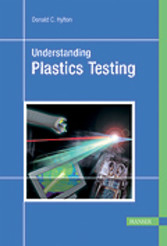Donald C. Hylton
Understanding Plastics Testing
Preface
6
Acknowledgements
8
Contents
10
1 The Science of Testing
14
1.1 Why Test?
14
1.2 Meeting the Standard – American Society for Testing and Materials International (ASTM)
14
2 Understanding Polymers and Their Behavior
18
2.1 Basic Polymer Science
18
2.2 Polymer Chemistry
19
2.3 Molecular Weight and Molecular Weight Distribution
21
2.4 Polymer Architecture or Morphology
22
2.5 Polymer Rheology
25
2.5.1 Deformation, Stress, and Strain
25
3 Mechanical Properties
30
3.1 Mechanical Testing in the Solid State
30
3.2 The Tensile Test (ASTM D638, ISO 527)
32
3.3 Flexural Testing (ASTM D790, ISO 178)
34
3.4 Dynamic Mechanical Testing (ASTM D5279)
36
3.5 Impact Testing
40
3.5.1 Falling Dart Impact ASTM D5420 (No ISO Method)
40
3.5.2 Instrumented Impact Testing ASTM D3763 (ISO 6603.2)
42
3.5.3 Izod – Charpy Impact (ASTM D256, D4812, ISO 179)
44
3.6 Compression Tests – ASTM D695 (ISO 604)
45
3.7 Solid State Creep Test – ASTM D2990 (ISO 899)
47
4 Thermal Testing
50
4.1 Introduction
50
4.2 Heat Deflection Test (ASTM D648, ISO 75)
51
4.3 Vicat Softening (ASTM D1525, ISO 306)
52
4.4 Differential Scanning Calorimetry, DSC (ASTM D3417, D3418)
53
4.5 Thermogravimetric Analysis (TGA)
53
4.6 Thermomechanical Analysis (TMA)
55
4.7 Thermal Conductivity, K-Factor (ASTM C177)
55
4.8 Thermal Expansion (ASTM D696, ISO 3167)
56
4.9 Orientation, Shrinkage (ASTM D2732, ISO 11501, D2838)
57
4.10 Free Standing Orientation Test (ASTM D1204)
57
5 Viscous Flow Properties
58
5.1 Introduction
58
5.2 Melt Index Test (ASTM D1238, ISO 1133)
61
5.3 Capillary Rheometry (ASTM D3595)
62
5.4 Rotational Rheometry (ASTM D4440)
65
5.4.1 Cone and Plate
68
5.4.2 Parallel Plates
69
5.4.3 Concentric Cylinder – Couettes
70
5.5 Solution Rheometry (ASTM 2857, ISO 1628)
71
5.6 Creep Test for Molten Polymers
72
6 Quality in the Testing Laboratory
74
6.1 What is Quality?
74
6.2 Quality Management
75
6.3 Cultural Diversity and Quality
76
6.4 Accuracy, Precision, and Bias
79
6.5 Review of Basic Statistics
80
6.6 Reasons for Data Variability
82
6.7 Statistical Process Control (SPC)
82
6.8 Quality Accreditation and Sanctioning Organizations
85
6.8.1 American Association of Laboratory Accreditation (A2LA)
85
6.8.2 International Standards Organization Sanctioning (ISO/IEC 17025)
87
Reference Materials
90
Appendix 1
92
Appendix 2
94
Appendix 3
96
Appendix 4
98
Index
100
© 2009-2024 ciando GmbH
 Zu Hanser-Fachbuch.de
Zu Hanser-Fachbuch.de
 Warenkorb
Warenkorb
